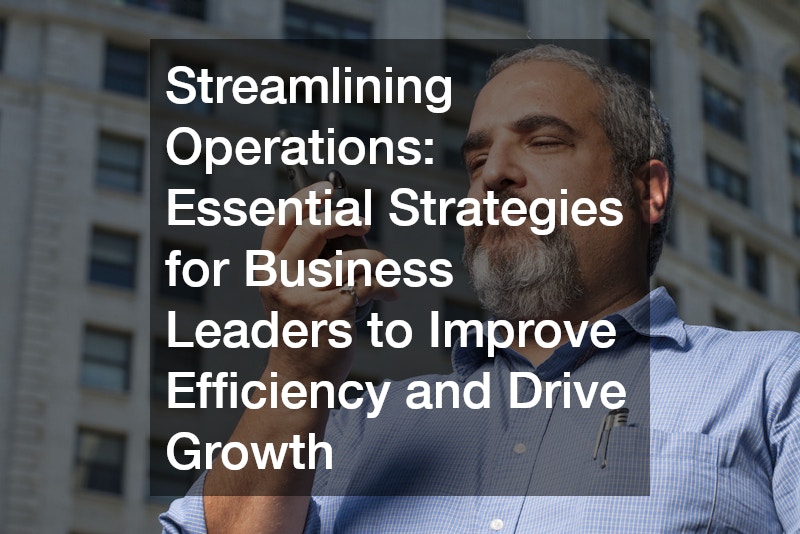As a business leader, your ability to streamline operations is critical to driving growth, improving profitability, and enhancing overall efficiency. Every decision you make—from managing your team to optimizing workflows—affects the success of your company. Streamlining operations isn’t just about cutting costs; it’s about creating a more agile, productive, and sustainable business that can thrive in an increasingly competitive marketplace.
In this article, we’ll explore actionable strategies that business leaders can implement to streamline operations. These strategies will help you eliminate inefficiencies, foster a productive work environment, and ensure that your business is poised for long-term success.
1. Leverage Technology to Automate Repetitive Tasks
In today’s digital age, technology plays a significant role in improving business efficiency. One of the most effective ways to streamline operations is by automating repetitive tasks. By adopting the right tools and software, you can free up valuable time for your team and reduce the likelihood of human error.
Consider implementing tools that automate processes such as data entry, customer relationship management (CRM), invoicing, payroll, and inventory management. Popular automation platforms like Zapier, Monday.com, and Trello can help integrate different parts of your business, making workflows more seamless and efficient.
For example, automating your invoicing process can save time and reduce the risk of missed payments. Similarly, customer support automation tools can handle common queries, allowing your team to focus on more complex customer needs.
Tip for Business Leaders: Assess your daily operations and identify tasks that are repetitive or time-consuming. Look for software solutions that can help automate those tasks to streamline your workflow.
2. Foster a Culture of Continuous Improvement
In order to streamline operations effectively, it’s essential to foster a culture of continuous improvement within your organization. This approach focuses on constantly evaluating and optimizing processes to make them more efficient and effective.
Encourage your team to regularly review workflows, identify bottlenecks, and suggest improvements. Emphasize the importance of incremental changes that, over time, will lead to significant improvements in overall operations.
You can implement continuous improvement methodologies like Lean or Six Sigma, which focus on minimizing waste and optimizing processes. These methodologies have been widely adopted by businesses to improve quality and efficiency, especially in production environments.
Tip for Business Leaders: Regularly solicit feedback from your team on ways to improve internal processes. Acknowledging and implementing small changes can result in major gains in efficiency over time.
3. Prioritize Communication and Collaboration

Effective communication is at the heart of any streamlined operation. Business leaders must prioritize open and transparent communication to ensure that everyone is aligned with company goals and objectives.
Collaboration tools like Slack, Microsoft Teams, and Zoom can improve communication and reduce the need for time-consuming in-person meetings. These platforms enable real-time collaboration, file sharing, and team coordination, which can significantly enhance productivity.
Additionally, implementing a clear internal communication strategy will ensure that all team members are informed and up-to-date on company developments. When teams communicate more effectively, projects move forward smoothly, and tasks are completed more efficiently.
Tip for Business Leaders: Invest in communication tools and establish protocols for clear, consistent, and efficient communication within your team.
4. Streamline Your Supply Chain
For businesses that rely on physical products or services, optimizing your supply chain is key to reducing costs and ensuring timely delivery. A streamlined supply chain not only lowers expenses but also improves customer satisfaction and brand loyalty.
Start by assessing your current suppliers, inventory management systems, and logistics strategies. Identify areas where delays, excess inventory, or unnecessary costs are creeping in. Look for opportunities to consolidate shipments, negotiate better pricing with vendors, and reduce inventory holding costs.
Adopting technologies like enterprise resource planning (ERP) systems or supply chain management (SCM) software can help you get a more holistic view of your supply chain, allowing you to optimize it more effectively.
Tip for Business Leaders: Evaluate your suppliers and processes regularly to identify inefficiencies and opportunities for improvement. A streamlined supply chain can give your business a competitive edge.
5. Focus on Employee Training and Development
Streamlining operations isn’t just about the tools or processes you use; it’s also about empowering your employees with the skills they need to work more efficiently. Investing in employee training and development ensures that your team has the right skills to succeed in their roles.
Providing ongoing training allows employees to stay up-to-date with industry trends, new technologies, and best practices. This not only helps them perform their tasks more effectively but also increases job satisfaction and retention.
Consider implementing a training program that includes both technical skills and soft skills development. Employees who are well-trained in both areas are more likely to contribute positively to your company’s goals and streamline operations.
Tip for Business Leaders: Make employee training a priority to ensure your team is equipped with the skills they need to succeed in an evolving business landscape.
6. Simplify Decision-Making with Data-Driven Insights
Making informed decisions is crucial for streamlining operations and achieving business success. As a business leader, relying on data-driven insights allows you to make more accurate, effective decisions that align with your goals.
Utilize business intelligence tools and dashboards to track key performance indicators (KPIs), financial metrics, and operational data. Tools like Tableau, Power BI, and Google Analytics can help you gather and analyze data in real-time, giving you a clearer understanding of where your business stands.
For example, by tracking inventory levels, sales data, and customer behavior, you can identify trends and make decisions that help you optimize operations. With data-driven insights, you’ll be able to forecast demand, streamline resource allocation, and improve overall efficiency.
Tip for Business Leaders: Use business intelligence tools to collect and analyze data that informs your decision-making processes. This will help you make smarter, faster decisions that improve operational efficiency.
7. Outsource Non-Core Functions
Outsourcing non-core functions is a strategy that allows businesses to focus on their strengths while leaving specialized tasks to third-party experts. Whether it’s accounting, IT support, marketing, or customer service, outsourcing can free up internal resources and reduce overhead costs.
Outsourcing is especially beneficial for small businesses or startups that lack the resources to manage all functions in-house. By outsourcing, you can access high-quality services without the need to invest in additional staff or infrastructure.
When selecting an outsourcing partner, look for a provider that aligns with your company’s values and understands your industry’s needs. Consider working with outsourcing experts who specialize in specific areas, such as payroll processing or digital marketing, to ensure that your business receives top-notch service.
Tip for Business Leaders: Identify functions that can be outsourced to improve efficiency and reduce costs. Outsourcing can help you scale your business without overburdening your team.
8. Implement Agile Project Management
Agile project management is a flexible and iterative approach to managing projects. It focuses on delivering small, incremental improvements over time, which can lead to faster results and a more adaptive business model.
By implementing agile principles, your team can work in short, focused sprints to deliver key outcomes. This allows your business to respond more quickly to changing market conditions, customer demands, or internal challenges.
Tools like Jira, Asana, and Basecamp can help your team manage projects in an agile way, enabling better collaboration, task tracking, and resource allocation.
Tip for Business Leaders: Adopt agile project management practices to increase flexibility and improve the speed and quality of your projects.
9. Reevaluate Your Business Model for Efficiency
Finally, streamlining operations may involve reevaluating your entire business model. Is your current model scalable? Are there areas where you can cut costs without sacrificing quality? By reassessing your business model, you can identify ways to streamline your operations while driving growth.
Consider examining aspects like your product offerings, pricing strategy, and customer service model. Is there an opportunity to reduce complexity or introduce new efficiencies? By optimizing your business model, you can ensure that your company is operating at maximum efficiency.
Tip for Business Leaders: Regularly assess your business model to identify inefficiencies and areas for improvement. A well-designed business model will help streamline your operations and support long-term growth.
Conclusion: Streamlining Operations for Sustainable Success
As a business leader, the key to success lies in your ability to streamline operations, making your business more agile, efficient, and profitable. By leveraging technology, fostering a culture of continuous improvement, and prioritizing communication, you can optimize your business processes and set your company on a path toward long-term success.
Take action today by implementing the strategies outlined in this article. Whether you start with automating tasks, improving employee training, or optimizing your supply chain, each step you take will bring you closer to achieving a more efficient and effective business.
